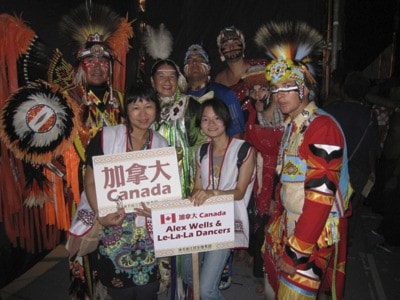Not many people take a couple of bags of goose down, a blanket and some tanned hides with them on a trip. But that’s just what Andy Everson packed when he went to Taiwan this July.
Everson and six other Canadian First Nation performers participated in the Global Indigenous Peoples Performing Arts in Taiwan. The July 27 to Aug. 3 event marked the country’s 100th anniversary with a celebration of indigenous culture.
In an opening speech, CIP Minister Paelabang Danapan acknowledged that this was the first time so many foreign indigenous dancers have performed in Taiwan.
“Dance constitutes a great part of aboriginal culture everywhere around the world because it demonstrates how people dialogue with nature,” he said in an interview with the China Post.
The festival showcased performers from a dozen nations; the group Everson was with was the only one from North America.
“It was a challenge for us to represent Canada as there are so many indigenous cultures here,” says Everson who is a member of the K'ómoks Band. “We could only present a very small cross-section.”
The Canadian contingent of the festival was organized by Alex Wells, a three-time world champion hoop dancer from Mount Currie.
To round out his performance, Wells invited Pow Wow dancers Luke Whiteman and Shirley Hill, Pow Wow singer Nelson Leon and Le La La dancers Jason and Zack Taylor and Everson to join him. Everson, founder of the local Kumugwe Dancers, was the only person from the Comox Valley.
With 19 groups performing, each dance was only allowed about 10 minutes.
“It was just a tiny sample of our culture,” says Everson.
Performers were bused to a different location each day and often participated in a parade before taking their act onstage in a tent.
“The biggest challenge,” says Everson, “was the heat. It was around 35 degrees and very humid. Our dances are meant to be performed in the winter so our regalia includes wool button blankets, headdresses and fur. We were out in the heat most of the day so had to make sure we stayed hydrated. No one wanted to get heatstroke and pass out on the stage.”
In the spirit of cross-culturalism and to keep cool during parades, the troupe got some Taiwanese farmer's hats and used felt pens to paint First Nation designs on them. The also drank lots of water.
The drums, however, were a different story.
“I performed in Taiwan four years ago so knew how the humidity would affect our drums,” Everson explains. “We took the tightest ones we had. But unless you were in an air-conditioned venue, it was almost impossible to keep them dried out. Mostly it was OK, but there were a few flat sounds and there was nothing we could do about it.”
A highlight for Everson was performing at the Chiang Kai-shek Memorial Hall in front of 10,000 spectators.
“The show was broadcast in Taipei so there were cameras everywhere,” he says. “It was really exciting to perform in front of such a large crowd.”
A Taiwanese anchorwoman told the dancers she could tell they tried to stay close to their cultural traditions and not embellish them.
“We acknowledge that we’re performing but try not to twist our culture in ways it’s not meant to be,” says Everson.
One thing Everson noticed was that all the performers spoke the colonial language of their home country.
“No one spoke their indigenous language,” he says. “It was English, French, Spanish or Mandarin. We all shared that history of what happens when a country is colonialized.”
One night, some Polynesian groups were comparing their indigenous languages and asking Everson how to say different words in his language.
“No one could speak their indigenous language, but they all knew some words,” says Everson. “My words for things were very different, but theirs all had a similar sound. I realized that they all lived different lives and had different indigenous languages but also had this common thread and history of words that go way back to common origins. It was a powerful moment.”
The festival was funded by the Taiwanese government, which hopes to make it an annual event.
“It was a great experience,” says Everson. “It really helps put things in perspective about how good we have it in Canada. In Taiwan, it wasn’t unusual to see an entire family, including an infant, bouncing along on a scooter to get from one place to another. Seeing something like that makes you appreciate what we have.”
